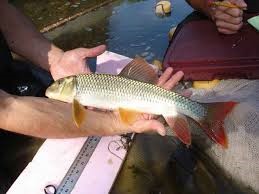Status: Threatened Provincially and Nationally
Description:
The Black Redhorse is a member of the sucker fish. It sucks in materials from the bottom and then expels any silt (earthy matter, fine sand, or the like).They eat crustaceans and insects. The younger fish are thought to prefer plankton. It will grow to about 50 cm. in length and weigh up to 1 kilo. The age of maturity is between two and six years, some individuals have been known to reach the age of 16.
Important Dates:
2008: Species assessed as Threatened under the Endangered Species Act
June 30, 2013: Species granted Habitat Protection
Range:
- In Canada, the Black Redhorse is found only in southwestern Ontario at a few locations in the Bayfield River, Maitland River, Ausable River, Grand River, Thames River and Specier Creek ; and
- It occurs in clean, swift flowing creeks and rivers with bottoms of gravel, rock, or sand and has a low tolerance for pollution.
Habitat:
- Generally lives in moderately sized rivers and streams, and with generally moderate to fast currents. In summer, they generally prefer pools and overwinter in deeper pools; and
- Spring spawning has been observed in water temperatures between 15-21 degrees celsius and eggs are laid on gravel in fast water.
Threats:
- The decline of the Black Redhorse in Ontario was probably caused by overfishing and habitat alteration;
- Current threats include dam construction and reservoir development; and
- The Black Redhorse requires clean, clear water and does not do well in rivers that are muddy or polluted.
Protection:
- Protected under the habitat section of the Fisheries Act;
- Protected under Ontario’s Endangered Species Act, 2007;
What YOU Can Do to Help:
- If you have an encounter with the Black Redhorse, ensure that you report your sighting with the Ministry of Natural Resources and Forestry. The Natural Heritage Information Centre has a handy online form to assist with this (find out how to do that here)
- Maintaining the flows at the run-of-the-river would be helpful, especially during spawning.
FUN FACTS:
- Every year between May and June, the sides of a male black redhorse darken to a greenish-black, and a pink stripe runs the length of its body. After spawning season, this colouration fades to a bluish-silver; and
There are a total of seven Redhorse species in Canada, the Black Redhorse is distinguishable based on a combination of tail colour, lip formation and scale counts – very hard to tell them



